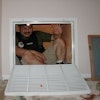Unvented Roofs without Spray Foam: The Rest of the Story

About this course
Learning Objectives
- Explain the moisture risks inherent in unvented/compact roof assemblies with fibrous (air‐permeable) insulation
- Define the roles that vapor diffusion and air leakage have on moisture levels in roofs
- Explain the role that a vapor diffusion vent can have in ameliorating roof moisture risks
- Describe the risks of inward vapor drive in unvented roof assemblies
Course outline
Module 1 • 2 assignments
Unvented Roofs without Spray Foam: The Rest of the Story
Instructor

Kohta Ueno
Kohta Ueno is a senior associate at Building Science Corporation, a building science consulting and architecture firm with offices in Boston, Massachusetts and Waterloo, Ontario. His responsibilities at Building Science Corporation include forensic field investigations, energy and hygrothermal modeling, building science research, and field testing. His undergraduate...